
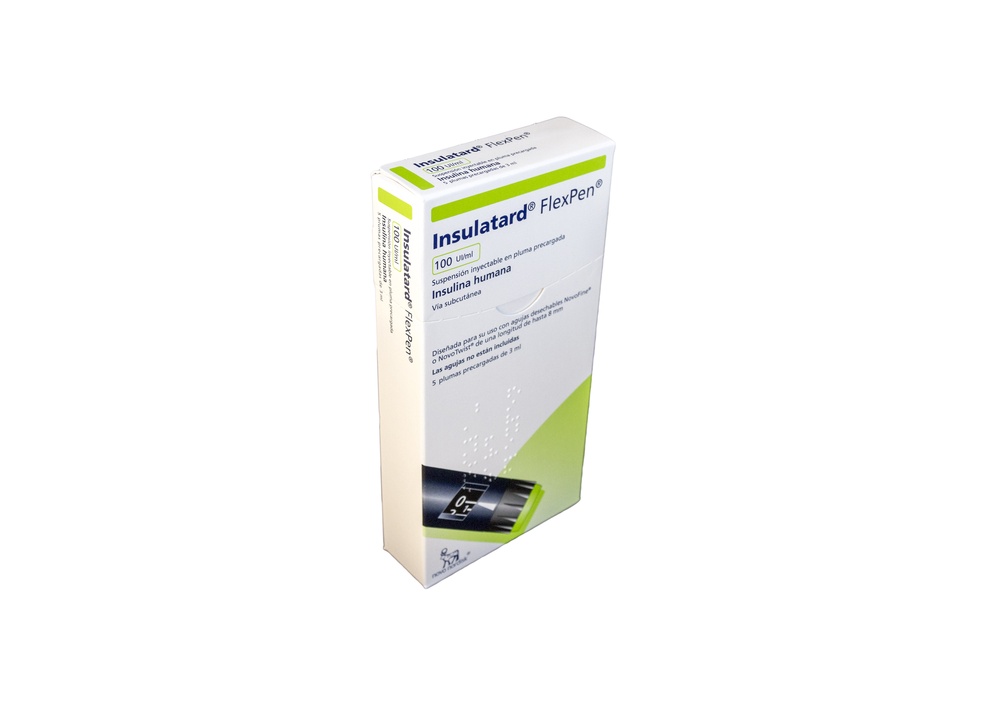
ІНСУЛАТАРД ФЛЕКСПЕН 100 ОД/мл СУСПЕНЗІЯ ДЛЯ ІН'ЄКЦІЙ У ПЕРЕДНАПОВНЕНІЙ ШПРИЦ-РУЧЦІ

Запитайте лікаря про рецепт на ІНСУЛАТАРД ФЛЕКСПЕН 100 ОД/мл СУСПЕНЗІЯ ДЛЯ ІН'ЄКЦІЙ У ПЕРЕДНАПОВНЕНІЙ ШПРИЦ-РУЧЦІ

Інструкція із застосування ІНСУЛАТАРД ФЛЕКСПЕН 100 ОД/мл СУСПЕНЗІЯ ДЛЯ ІН'ЄКЦІЙ У ПЕРЕДНАПОВНЕНІЙ ШПРИЦ-РУЧЦІ
Введення
Опис:інформація для користувача
Інсулатард ФлексПен 100МО/мл (мііжнародні одиниці/мл) суспензія для ін'єкцій у попередньо заповненому стилусі
Людський інсулін
Перш ніж почати використовувати цей лікарський засіб, уважно прочитайте весь опис, оскільки він містить важливу інформацію для вас.
- Збережіть цей опис, оскільки вам може знадобитися знову його прочитати.
- Якщо у вас виникли питання, проконсультуйтеся з вашим лікарем, фармацевтом або медсестрою.
- Цей лікарський засіб призначений тільки вам, і не слід давати його іншим людям, навіть якщо вони мають такі самі симптоми, як і ви, оскільки це може їм нашкодити.
- Якщо ви відчуваєте побічні ефекти, проконсультуйтеся з вашим лікарем, фармацевтом або медсестрою, навіть якщо це побічні ефекти, які не наведені в цьому описі. Див. розділ 4.
Зміст опису
- Що таке Інсулатард і для чого він використовується
- Що потрібно знати перед початком використання Інсулатарду
- Як використовувати Інсулатард
- Можливі побічні ефекти
- Збереження Інсулатарду
- Зміст упаковки та додаткова інформація
1. Що таке Інсулатард і для чого він використовується
Інсулатард - це людський інсулін з поступовим початком дії і тривалою дією.
Інсулатард використовується для зниження підвищених рівнів цукру в крові у пацієнтів з цукровим діабетом (цукровим діабетом). Цукровий діабет - це захворювання, при якому ваш організм не виробляє достатньо інсуліну для контролю рівня цукру в крові. Лікування Інсулатардом допомагає запобігти ускладненням цукрового діабету.
Інсулатард починає знижувати рівень цукру в крові приблизно за 1 годину 30 хвилин після ін'єкції, і ефект триває приблизно 24 години. Інсулатард зазвичай вводять у поєднанні з препаратами інсуліну швидкої дії.
2. Що потрібно знати перед початком використання Інсулатарду
Не використовувати Інсулатард
- Якщо ви алергічні на людський інсулін або на будь-який інший компонент цього лікарського засобу, див. розділ 6.
- Якщо ви підозрюєте, що починаєте відчувати гіпоглікемію (низький рівень цукру в крові), див. Резюме важливих побічних ефектів у розділі 4.
- У помпах для інфузії інсуліну.
- Якщо ФлексПен впав, пошкоджений або розбитий.
- Якщо він не зберігався правильно або якщо його заморожували, див. розділ 5.
- Якщо інсулін, що піддався ресуспензії, не має однорідного білого та мутного вигляду.
Якщо виникає будь-яка з цих обставин, не використовувати Інсулатард. Проконсультуйтеся з вашим лікарем, фармацевтом або медсестрою.
Перед використанням Інсулатарду
?Перевірте етикетку, щоб переконатися, що це правильний тип інсуліну.
? Використовуйте завжди нову голку для кожної ін'єкції, щоб уникнути забруднення.
? Голки та Інсулатард ФлексПен не повинні передаватися іншим людям.
? Інсулатард ФлексПен призначений тільки для ін'єкцій під шкіру. Проконсультуйтеся з вашим лікарем, якщо вам потрібно вводити інсулін іншим способом.
Попередження та застереження
Деякі порушення та дії можуть впливати на ваші потреби в інсуліні. Проконсультуйтеся з вашим лікарем:
- Якщо у вас є проблеми з нирками, печінкою, наднирниками, гіпофізом або щитоподібною залозою.
- Якщо ви робите більше фізичних вправ, ніж зазвичай, або якщо ви хочете змінити свою звичайну дієту, оскільки це може впливати на рівень цукру в крові.
- Якщо ви хворі, вам потрібно продовжувати використовувати інсулін і проконсультуватися з вашим лікарем.
- Якщо ви плануєте поїхати за кордон, поїздка в різні часові зони може впливати на ваші потреби в інсуліні та на час введення інсуліну.
Зміни шкіри в місці ін'єкції
Необхідно змінювати місце ін'єкції, щоб допомогти уникнути змін у жировій тканині, таких як загострення шкіри, її звуження або утворення підшкірних шишок. Інсулін може не діяти дуже добре, якщо його вводять в місце з такими змінами. Повідоміть вашому лікареві про будь-які зміни в місці ін'єкції. Повідоміть вашому лікареві, якщо ви зараз вводите інсулін в ці пошкоджені місця, перш ніж почнете вводити інсулін в інше місце. Ваш лікар може порадити вам перевірити рівень цукру в крові більш часто та调整 інсулін або дозу інших антидіабетичних ліків.
Інші лікарські засоби та Інсулатард
Повідоміть вашому лікареві, фармацевту або медсестрі, якщо ви приймаєте, нещодавно приймали або можете приймати інші лікарські засоби.
Деякі лікарські засоби можуть впливати на рівень цукру в крові, і це може означати, що доза інсуліну повинна бути змінена. Нижче наведено найбільш поширені лікарські засоби, які можуть впливати на ваше лікування інсуліном.
Рівень цукру в крові може знижуватися (гіпоглікемія), якщо ви приймаєте:
- Інші лікарські засоби для лікування цукрового діабету
- Інгібітори моноамінооксидази (МАО) (використовуються для лікування депресії)
- Бета-блокатори (використовуються для лікування високого артеріального тиску)
- Інгібітори ангіотензинперетворюючого ферменту (ІАПФ) (використовуються для лікування певних серцевих захворювань або високого артеріального тиску)
- Саліцилати (використовуються для полегшення болю та зниження температури)
- Анаболіки стероїди (наприклад, тестостерон)
- Сульфонаміди (використовуються для лікування інфекцій).
Рівень цукру в крові може підвищуватися (гіперглікемія), якщо ви приймаєте:
- Оральні контрацептиви (таблетки для контрацепції)
- Тіазиди (використовуються для лікування високого артеріального тиску або надмірної ретенції рідини)
- Глюкокортикоїди (наприклад, кортизон, використовується для лікування запалення)
- Тиреоїдний гормон (використовується для лікування захворювань щитоподібної залози)
- Симпатикоміметики (наприклад, адреналін, салбутамол або тербуталін, використовуються для лікування астми)
- Гормон росту (лікарський засіб для стимулювання росту кісток та соматичних процесів і з значним впливом на метаболічні процесси організму)
- Даназол (лікарський засіб, який впливає на овуляцію).
Октреотид і ланреотид (використовуються для лікування аkromегалії, рідкого гормонального захворювання, яке зазвичай трапляється у дорослих середнього віку, викликаного надмірною продукцією гормону росту гіпофізом) можуть підвищувати або знижувати рівень цукру в крові.
Бета-блокатори (використовуються для лікування високого артеріального тиску) можуть послаблювати або повністю придушувати перші симптоми попередження, які допомагають розпізнати низький рівень цукру в крові.
Піоглітазон (таблетки, використовувані для лікування цукрового діабету 2 типу)
Деякі пацієненти з цукровим діабетом 2 типу тривалого перебігу та попереднім захворюванням серця або інсультом, які були лікувані піоглітазоном та інсуліном, розвинули серцеву недостатність. Повідоміть вашому лікареві якомога швидше, якщо ви маєте ознаки серцевої недостатності, такі як незвичайна відсутність повітря, швидке збільшення ваги або локалізоване набухання (едем).
Якщо ви приймали будь-який з лікарських засобів цього списку, повідоміть вашому лікареві, фармацевту або медсестрі.
Використання Інсулатарду з алкоголем
? Якщо ви споживаєте алкоголь, ваші потреби в інсуліні можуть змінитися, оскільки рівень цукру в крові може підвищуватися або знижуватися. Рекомендується дотримуватися суворого контролю.
Вагітність і лактація
? Якщо ви вагітні, вважаєте, що можете бути вагітні або плануєте вагітність, проконсультуйтеся з вашим лікарем перед використанням цього лікарського засобу. Інсулатард можна використовувати під час вагітності. Можливо, буде потрібно змінити дозу інсуліну під час вагітності та після пологів. Суворий контроль цукрового діабету, особливо для запобігання гіпоглікемії, важливий для здоров'я вашої дитини.
? Не маються обмеження на лікування Інсулатардом під час лактації.
Проконсультуйтеся з вашим лікарем, фармацевтом або медсестрою перед використанням цього лікарського засобу під час вагітності або періоду лактації.
Водіння транспортних засобів і використання машин
? Спитайте вашого лікаря, чи можете ви водити транспортні засоби або керувати машиною:
- Якщо ви часто відчуваєте гіпоглікемію.
- Якщо вам важко розпізнати симптоми гіпоглікемії.
Якщо ваш рівень цукру в крові високий або низький, це може впливати на вашу концентрацію та реакцію, а також на вашу здатність водити транспортні засоби або керувати машиною. Враховуйте, що ви можете піддати себе або інших людей небезпеці.
Інсулатард містить натрій
Інсулатард містить менше 1 ммоль натрію (23 мг) на дозу; це означає, що він практично "не містить натрію".
3. Як використовувати Інсулатард
Доза і час введення інсуліну
Дотримуйтесь точно інструкцій з введення цього лікарського засобу та дози, призначеної вашим лікарем. У разі сумнівів проконсультуйтеся з вашим лікарем, фармацевтом або медсестрою.
Не змінюйте інсулін, якщо ваш лікар не порадить вам цього. Якщо він змінює тип або марку інсуліну, можливо, буде потрібно змінити дозу.
Використання в дітей та підлітків
Інсулатард можна використовувати в дітей та підлітків.
Використання в спеціальних групах пацієнтів
Якщо у вас є ниркова або печінкова недостатність або якщо вам більше 65 років, вам потрібно перевірити рівень цукру в крові більш часто та проконсультуватися з вашим лікарем про можливі зміни дози інсуліну.
Як і де вводити інсулін
Інсулатард вводять під шкіру (підшкірна ін'єкція). Ніколи не вводьте інсулін прямо в вену (внутрішньовенна ін'єкція) або м'яз (внутрішньом'язова ін'єкція). Інсулатард ФлексПен призначений тільки для ін'єкцій під шкіру. Проконсультуйтеся з вашим лікарем, якщо вам потрібно вводити інсулін іншим способом.
З кожною ін'єкцією змінюйте місце ін'єкції всередині певної ділянки шкіри, яку ви використовуєте. Це може зменшити ризик розвитку підшкірних шишок та загострення шкіри, див. розділ 4. Найкращими місцями для ін'єкції є: передня частина талії (живіт), ягодиці, передня частина стегна або верхня частина руки. Ефект інсуліну буде швидшим, якщо ін'єкцію зробити в талії (живіт). Вам потрібно регулярно перевіряти рівень цукру в крові.
Як обробляти Інсулатард ФлексПен
Інсулатард ФлексПен - це попередньо заповнений стилус, який містить людський інсулін ізофан (НФГ).
Уважно прочитайте інструкції з використання Інсулатарду ФлексПен, які додані до цього опису. Ви повинні використовувати стилус так, як описано в інструкціях з використання Інсулатарду ФлексПен.
Завжди переконуйтесь, що ви використовуєте правильний стилус перед ін'єкцією інсуліну.
Якщо ви використовуєте більше інсуліну, ніж потрібно
Якщо ви використовуєте надмірну кількість інсуліну, ваш рівень цукру в крові занадто низький (гіпоглікемія). Див. Резюме важливих побічних ефектів у розділі 4.
Якщо ви забули використати інсулін
Якщо ви забули використати інсулін, ваш рівень цукру в крові може підвищитися занадто (гіперглікемія). Див. Ефекти, пов'язані з цукровим діабетом, у розділі 4.
Якщо ви припиняєте лікування інсуліном
Не припиняйте використовувати інсулін без попередньої консультації з вашим лікарем, який пояснить, що вам потрібно зробити. Припинення інсуліну може викликати надмірне підвищення рівня цукру в крові (важка гіперглікемія) та кетоацидоз. Див. Ефекти, пов'язані з цукровим діабетом, у розділі 4.
Якщо у вас є інші питання щодо використання цього лікарського засобу, проконсультуйтеся з вашим лікарем, фармацевтом або медсестрою.
4. Можливі побічні ефекти
Як і всі лікарські засоби, цей лікарський засіб може викликати побічні ефекти, хоча не всі люди їх відчувають.
Резюме важливих побічних ефектів
Зниження рівня цукру в крові (гіпоглікемія)- це дуже поширений побічний ефект. Він може впливати на понад 1 з 10 осіб.
Рівень цукру в крові може знижуватися, якщо:
- Ви вводите надмірну кількість інсуліну.
- Ви їсте дуже мало або пропускаєте прийом їжі.
- Ви робите більше фізичних вправ, ніж зазвичай.
- Ви споживаєте алкоголь, див. Використання Інсулатарду з алкоголем у розділі 2.
Симптоми зниження рівня цукру в крові: холодний пот, холодна та бліда шкіра, головний біль, прискорене серцебиття, відчуття нездоров'я, надмірний апетит, тимчасові порушення зору, сонливість, незвичайна втома та слабкість, нервозність або тремор, тривога, сплутаність, труднощі з концентрацією.
Важкий спад рівня цукру в крові може призвести до втрати свідомості. Якщо його не лікувати, це може викликати пошкодження мозку (тимчасове або постійне) та навіть смерть. Ви можете швидше відновити свідомість, якщо хтось, хто знає, як це зробити, введе вам ін'єкцію глюкагону. Якщо вам введено глюкагон, вам потрібно також прийняти глюкозу або цукрозмістний продукт якомога швидше після відновлення свідомості. Якщо ви не реагуєте на лікування глюкагоном, вам потрібно негайно звернутися до лікарні.
Що робити, якщо ви відчуваєте зниження рівня цукру в крові:
? Якщо ви відчуваєте зниження рівня цукру в крові, прийміть таблетки глюкози або інший цукрозмістний продукт (наприклад, цукерки, печиво, фруктовий сік). Якщо це можливо, виміряйте рівень цукру в крові та відпочиньте. Завжди носіть з собою таблетки глюкози або цукрозмістні продукти, на випадок якщо.
? Коли зникнуть симптоми низького рівня цукру в крові або коли ваш рівень цукру в крові стабілізується, продовжуйте лікування інсуліном звичайним чином.
? Якщо ваш рівень цукру в крові занадто низький, щоб ви могли втрачати свідомість, якщо вам потрібно була ін'єкція глюкагону або якщо ви відчували багато епізодів низького рівня цукру в крові, проконсультуйтеся з вашим лікарем. Можливо, вам потрібно буде змінити дозу або частоту введення інсуліну, ваші харчові звички або фізичні вправи.
Повідоміть відповідних осіб, що у вас є цукровий діабет, та про можливі наслідки, такі як ризик втрати свідомості (потеря свідомості) через низький рівень цукру в крові. Повідоміть їх, що якщо ви втрачите свідомість, їм потрібно повернути вас на бік та негайно звернутися за медичною допомогою. Вони не повинні давати вам їжу чи напої, оскільки ви можете задихнутися.
Важка алергічна реакціяна Інсулатард або на один з його компонентів (алергічна реакція системного типу) - це дуже рідкий побічний ефект, але він може бути смертельним. Він може впливати до 1 з 10 000 осіб.
Негайно зверніться до лікаря:
- Якщо симптоми алергії поширюються на інші частини тіла.
- Якщо ви раптом почуваєтеся погано та маєте пот, відчуття нездоров'я (нудоту), труднощі з диханням, прискорене серцебиття або головокружіння.
? Якщо ви помітили будь-які з цих симптомів, негайно зверніться за медичною допомогою.
Зміни шкіри в місці ін'єкції: Якщо ви вводите інсулін у одне й те саме місце, жирова тканина може звужитися (ліпоатрофія) або потовщитися (ліпогіпертрофія) (це може впливати до 1 з 100 осіб). Підшкірні шишки також можуть виникнути через накопичення білка, званого амілоїдом (кутанна амілоїдоз; не відомо, з якою частотою це відбувається). Інсулін може не діяти дуже добре, якщо його вводять у місце з такими змінами. Змініть місце ін'єкції, щоб допомогти уникнути цих змін шкіри.
Список інших побічних ефектів
Побічні ефекти рідкісні
Можуть впливати до 1 з 100 осіб
Симптоми алергії:можуть виникнути місцеві алергічні реакції (біль, червоність, висип, запалення, гематоми, набухання та свербіж) в місці ін'єкції. Зазвичай вони зникають за кілька тижнів після початку використання інсуліну. Якщо вони не зникають або поширюються на все тіло, вам потрібно негайно звернутися до лікаря. Див. також важкі алергічні реакції, описані вище.
Ретинопатія діабету(очне захворювання, пов'язане з цукровим діабетом, яке може викликати втрату зору): якщо у вас є ретинопатія діабету та ваш рівень цукру в крові покращується дуже швидко, ретинопатія може погіршитися. У цьому випадку вам потрібно проконсультуватися з лікарем.
Запалення суглобів:після початку лікування інсуліном накопичення рідини може викликати запалення суглобів. Зазвичай цей ефект швидко зникає. Якщо це не відбувається, проконсультуйтеся з лікарем.
Побічні ефекти дуже рідкісні
Можуть впливати до 1 з 10 000 осіб.
Проблеми з зором:після початку лікування інсуліном ваш зір може бути порушений, але зазвичай це тимчасово.
Больова нейропатія(біль через пошкодження нервів): якщо ваш рівень цукру в крові покращується дуже швидко, ви можете відчувати біль, пов'язаний з нервами. Це називається гостра больова нейропатія та зазвичай є тимчасовою.
Звіт про побічні ефекти
Якщо ви відчуваєте будь-який побічний ефект, проконсультуйтеся з лікарем, фармацевтом або медсестрою, навіть якщо це побічні ефекти, які не наведені в цьому описі. Ви також можете повідомити про них безпосередньо через Систему моніторингу лікарських засобів України: www.notificaRAM.es. Надсилаючи повідомлення про побічні ефекти, ви можете допомогти надати більше інформації про безпеку цього лікарського засобу.
Ефекти, пов'язані з цукровим діабетом
Високий рівень цукру в крові (гіперглікемія)
Ви можете відчувати високий рівень цукру в крові, якщо:
- Ви не вводите достатньо інсуліну.
- Ви забули ввести інсулін або припинили його використання.
- Ви повторно вводите менше інсуліну, ніж потрібно.
- Ви страждаєте на інфекцію та/або гарячку.
- Ви їсте більше, ніж зазвичай.
- Ви робите менше фізичних вправ, ніж зазвичай.
Симптоми попередження високого рівня цукру в крові:
Симптоми попередження з'являються поступово та включають надмірну сечовипускання, спрагу, втрату апетиту, відчуття нездоров'я (нудоту або блювоту), сонливість або втома, суху шкіру та червоність, сухість у роті та запах ацетону з диханням.
Що робити у разі підвищення рівня цукру в крові:
? Якщо ви відчуваєте будь-який з цих симптомів: перевірте рівень цукру в крові та наявність кетонів у сечі, якщо це можливо, та негайно зверніться до лікаря.
? Це можуть бути симптоми важкого захворювання, званого кетоацидозом діабету (утворення кислоти в крові через те, що організм розкладає жир замість цукру). Якщо його не лікувати, це може викликати діабетичну кому та навіть смерть.
5. Зберігання Інсулатарду
Тримайте цей лікарський засіб поза зоною видимості та досягнення дітей.
Не використовуйте цей лікарський засіб після закінчення терміну придатності, зазначеного на етикетці FlexPen та на упаковці після CAD. Термін придатності - останній день місяця, зазначеного.
До відкриття:зберігайте в холодильнику (між 2°C та 8°C). Тримайте його подалі від холодильного елемента. Не заморожуйте.
Під час використання або якщо ви берете його з собою:не охолоджуйте чи заморожуйте. Його можна носити з собою та зберігати при кімнатній температурі (нижче 30°C) до 6 тижнів.
Завжди зберігайте кришку пензля на вашому FlexPen, коли не використовуєте його, щоб захистити його від світла.
Викидайте голку після кожної ін'єкції.
Лікарські засоби не повинні викидатися в каналізацію чи сміття. Спитайте у вашого фармацевта, як позбутися упаковок та лікарських засобів, які вам більше не потрібні. Таким чином, ви допоможете захистити довкілля.
6. Зміст упаковки та додаткова інформація
Склад Інсулатарду
- Активний інгредієнт - людський інсулін. Інсулатард - це суспензія людського інсуліну ізофан (NPH). Кожен мл містить 100 ОД людського інсуліну. Кожна попередньо наповнена пenna містить 300 ОД людського інсуліну в 3 мл ін'єкційної суспензії.
- Інші компоненти - хлорид цинку, гліцерол, метакрезол, фенол, дигідрат дифосфату натрію, гідроксид натрію, хлоридна кислота, сульфат протаміну та вода для ін'єкційних препаратів.
Вигляд продукту та вміст упаковки
Інсулатард представлений у вигляді ін'єкційної суспензії. Після ресуспензії рідина повинна мати однорідний білий та мутний вигляд.
Розміри упаковок - 1, 5 та 10 попередньо наповнених пен 3 мл. Можливо, не всі розміри упаковок будуть доступні.
Суспензія - водна, біла та мутна.
Власник дозволу на продаж та відповідальний за виробництво
Власник дозволу на продаж
Novo Nordisk A/S,
Novo Allé, DK-2880 Bagsværd, Данія
Відповідальний за виробництво
Відповідальний за виробництво можна ідентифікувати за номером партії, надрукованим на кришці картонної упаковки та на етикетці:
- Якщо другий та третій символи - S6, P5, K7, R7, VG, FG або ZF, відповідальний за виробництво - Novo Nordisk A/S, Novo Allé, DK-2880 Bagsværd, Данія.
- Якщо другий та третій символи - H7 або T6, відповідальний за виробництво - Novo Nordisk Production SAS, 45 Avenue d’Orléans, F-28000 Chartres, Франція.
Дата останнього перегляду цієї інструкції:
Інші джерела інформації
Детальна інформація про цей лікарський засіб доступна на сайті Європейського агентства з лікарських засобів: http://www.ema.europa.eu.
На звороті включені інструкціїдля використанняFlexPen.
Інструкції для використанняІнсулатардсуспензію для ін'єкцій у FlexPen.
Вважно прочитайте наступні інструкції перед використанням вашого FlexPen.Якщо ви не дотримуєтеся інструкцій уважно, можна ввести занадто мало або занадто багато інсуліну, що може призвести до надто високого або надто низького рівня цукру в крові.
FlexPen - це попередньо наповнена пenna з дозуванням інсуліну. Можна вибрати дози від 1 до 60 одиниць, з кроком 1 одиниця. FlexPen призначений для використання з використанням відкидних голок NovoFine або NovoTwist довжиною до 8 мм. Як заходи обережності, завжди носіть з собою запасний пристрій для введення інсуліну на випадок, якщо ваш FlexPen буде втрачений або пошкоджений.

Перед використання пени
Ви повинні обережно поводитися з вашим FlexPen.
Якщо він впаде, пошкодиться або вдариться, існує ризик того, що інсулін вийде. Це може призвести до неточної дозування, що може призвести до надто високого або надто низького рівня цукру в крові.
Ви можете очистити зовнішню частину вашого FlexPen ватним тампоном, змоченим в алкоголі. Не слід занурювати його, мити чи змащувати, оскільки пenna може бути пошкоджена.
Не перезаправляйте ваш FlexPen. Як тільки він буде порожній, його слід викинути.
Підготовка Інсулатард FlexPen
А
Перевірте назву та кольорову етикетку вашої пени, щоб переконатися, що вона містить правильний тип інсуліну.Це особливо важливо, якщо ви використовуєте більше одного типу інсуліну. Якщо ви використовуєте неправильний тип інсуліну, ваш рівень цукру в крові може стати надто високим або надто низьким.
Коли ви використовуєте нову пену
Дайте інсуліну досягти кімнатної температури перед використанням.
Це полегшує ресуспензію.
Видаліть кришку пени (див. А).

Б
Перед першим введенням з новим FlexPen необхідно ресуспендувати інсулін:Перемістіть пену вверх і вниз двадцять разів між двома позиціями, як показано на малюнку, щоб скляна кулька переміщалася з одного кінця картриджа в інший. Повторюйте процедуру, поки рідина не стане однорідною білою та мутною.
Для кожної наступної ін'єкції перемістіть пену вверх і вниз між двома позиціями щонайменше 10 разів, поки рідина не стане однорідною білою та мутною.
Завжди переконуйтесь, що ви ресуспендували інсулін перед кожною ін'єкцією. Це зменшує ризик досягнення надто високого або надто низького рівня цукру в крові. Після ресуспензії інсуліну завершіть наступні кроки ін'єкції без затримки.
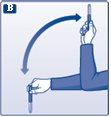
Завжди переконуйтесь, що в картриджі залишилося щонайменше 12 одиниць інсуліну для виконання ресуспензії. Якщо залишилося менше 12 одиниць, використовуйте новий FlexPen. 12 одиниць позначені на шкалі залишку. Див. велике зображення у верхній частині цієї інструкції.
Не використовуйте пену, якщо інсулін ресуспендуванийне має однорідного білого та мутноговигляду.
Монтаж голки
В
Видаліть паперову стрічку з нової відкидної голки.
Навініть голку прямо та твердо на ваш FlexPen.

Г
Видаліть великий зовнішній ковпачок голки та збережіть його для майбутнього використання.

Д
Видаліть внутрішній ковпачок голки та викиньте його.
Ніколи не намагайтесь знову встановити внутрішній ковпачок голки. Ви можете поранитися голкою.

Завжди використовуйте нову голку для кожної ін'єкції. Це зменшує ризик забруднення, інфекції, втрати інсуліну, забруднення голки та неточної дозування.
Будьте обережні, щоб не згинати чи пошкоджувати голку перед використанням.
Перевірка потоку інсуліну
Е
Перед кожною ін'єкцією можуть утворюватися невеликі кількості повітря в картриджі під час нормального використання. Для уникнення ін'єкції повітря та забезпечення правильної дозування:
Поверніть селектор дозування, щоб вибрати 2 одиниці.
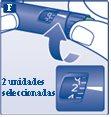
Ж
Тримайте ваш FlexPen з голкою, спрямованою вгору, та легонько постукуйте картридж пальцем кілька разів, щоб повітряні бульбашки осіли в верхній частині картриджа.

З
Тримайте голку вгору, натисніть кнопку до кінця, поки селектор дозування не повернеться до 0.
На кінчику голки повинна з'явитися краплина інсуліну. Якщо ні, замініть голку та повторюйте процедуру до шести разів.
Якщо краплина інсуліну не з'являється, пenna є дефектною, та ви повинні використовувати нову.
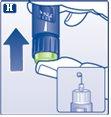
Завжди переконуйтесь, що на кінчику голки з'являється краплина перед ін'єкцією. Це гарантує, що інсулін тече. Якщо краплина не з'являється, інсулін не буде введений, хоча селектор дозування рухатиметься. Це може вказувати на те, що голка заблокована чи пошкоджена.
Завжди перевіряйте потік перед ін'єкцією. Якщо ви не перевіряєте потік, ви можете отримати недостатню кількість інсуліну або навіть жодної. Це може призвести до надто високого рівня цукру в крові.
Вибір дози
І
Перевірте, що селектор дозування встановлений на 0.
Поверніть селектор дозування, щоб вибрати кількість одиниць, які вам потрібно ввести.
Дозу можна коригувати вперед та назад, повертаючи селектор дозування в будь-якому напрямку, поки правильна доза не буде встановлена з маркером дозування. Коли ви повертаєте селектор дозування, будьте обережні, щоб не натиснути кнопку, оскільки інсулін може вийти.
Ви не можете вибрати дозу, більшу за кількість одиниць, які залишилися в картриджі.
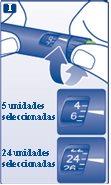
Перед ін'єкцією інсуліну завжди використовуйте селектор дозування та маркер дозування, щоб побачити, скільки одиниць ви вибрано.
Не рахуйте клацики пени. Якщо ви вибрано неправильну дозу та ввели її, ваш рівень цукру в крові може стати надто високим або надто низьким. Не використовуйте шкалу залишку інсуліну, оскільки вона показує лише приблизну кількість інсуліну, яка залишилася в пені.
Ін'єкція
Ї
Вставте голку під шкіру. Використовуйте техніку ін'єкції, вказану вашим лікарем або медсестрою.
Введіть дозу, натиснувши кнопку до кінця, поки 0 не буде встановлено з маркером дозування. Будьте обережні, щоб натиснути кнопку лише під час ін'єкції.
Повертаючи селектор дозування, ви не введете інсулін.
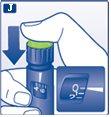
Й
Тримайте кнопку повністю натиснутою та тримайте голку під шкірою щонайменше 6 секунд. Це гарантує, що була введена повна доза.
Видаліть голку зі шкіри та, як тільки ви це зробите, звільніть кнопку.
Завжди переконуйтесь, що селектор дозування повертається до 0 після ін'єкції. Якщо селектор дозування зупиняється до досягнення 0, повна доза не була введена, що може призвести до надто високого рівня цукру в крові.

К
Накрийте голку великим зовнішнім ковпачком без доторку до неї. Коли голка буде накрита, обережно натисніть великий зовнішній ковпачок повністю, а потім відрізіть голку.
Викидайте її обережно та знову встановіть кришку пени.

Завжди викидайте голку після кожної ін'єкції та зберігайте ваш FlexPen без голки. Це зменшує ризик забруднення, інфекції, втрати інсуліну, забруднення голки та неточної дозування.
Інша важлива інформація
Особи, які доглядають за цими пацієнтами, повинні бути дуже обережними при роботі з використаними голками, щоб зменшити ризик випадкових уколів та інфекцій.
Викидайте ваш використаний FlexPen обережно без голки.
Ніколи не діліться пеною чи голками з іншими людьми. Це може призвести до інфекцій.
Ніколи не діліться пеною з іншими людьми. Ваш лікарський засіб може бути шкідливим для здоров'я цих людей.
Завжди тримайте пену та голки поза зоною видимості та досягнення інших людей, особливо дітей.

Скільки коштує ІНСУЛАТАРД ФЛЕКСПЕН 100 ОД/мл СУСПЕНЗІЯ ДЛЯ ІН'ЄКЦІЙ У ПЕРЕДНАПОВНЕНІЙ ШПРИЦ-РУЧЦІ в Іспанії у 2025 році?
ІНСУЛАТАРД ФЛЕКСПЕН 100 ОД/мл СУСПЕНЗІЯ ДЛЯ ІН'ЄКЦІЙ У ПЕРЕДНАПОВНЕНІЙ ШПРИЦ-РУЧЦІ коштує в середньому 38.03 євро у листопад, 2025 році. Ціна може змінюватися залежно від регіону, аптеки та наявності рецепта. Рекомендуємо перевіряти актуальну вартість у місцевих аптеках або через онлайн-сервіси.
- Країна реєстрації
- Середня ціна в аптеках38.03 EUR
- Діючі речовини
- Потрібен рецептТак
- Виробник
- Інформація є довідковою і не є медичною порадою. Перед прийомом будь-яких препаратів обов'язково проконсультуйтеся з лікарем. Oladoctor не несе відповідальності за медичні рішення, прийняті на основі цього контенту.
- Альтернативи до ІНСУЛАТАРД ФЛЕКСПЕН 100 ОД/мл СУСПЕНЗІЯ ДЛЯ ІН'ЄКЦІЙ У ПЕРЕДНАПОВНЕНІЙ ШПРИЦ-РУЧЦІФорма випуску: РОЗЧИН ДЛЯ ІН'ЄКЦІЙ, 100 МО/млДіючі речовини: insulin (human)Виробник: Lilly S.A.Потрібен рецептФорма випуску: РОЗЧИН ДЛЯ ІН'ЄКЦІЙ, 100 МО/млДіючі речовини: insulin (human)Виробник: Lilly S.A.Потрібен рецептФорма випуску: РОЗЧИН ДЛЯ ІН'ЄКЦІЙ, 100 МО/млДіючі речовини: insulin (human)Виробник: Novo Nordisk A/SПотрібен рецепт
Аналоги ІНСУЛАТАРД ФЛЕКСПЕН 100 ОД/мл СУСПЕНЗІЯ ДЛЯ ІН'ЄКЦІЙ У ПЕРЕДНАПОВНЕНІЙ ШПРИЦ-РУЧЦІ в інших країнах
Найкращі аналоги з тією самою діючою речовиною та терапевтичним ефектом.
Аналог ІНСУЛАТАРД ФЛЕКСПЕН 100 ОД/мл СУСПЕНЗІЯ ДЛЯ ІН'ЄКЦІЙ У ПЕРЕДНАПОВНЕНІЙ ШПРИЦ-РУЧЦІ у Польща
Аналог ІНСУЛАТАРД ФЛЕКСПЕН 100 ОД/мл СУСПЕНЗІЯ ДЛЯ ІН'ЄКЦІЙ У ПЕРЕДНАПОВНЕНІЙ ШПРИЦ-РУЧЦІ у Україна
Лікарі онлайн щодо ІНСУЛАТАРД ФЛЕКСПЕН 100 ОД/мл СУСПЕНЗІЯ ДЛЯ ІН'ЄКЦІЙ У ПЕРЕДНАПОВНЕНІЙ ШПРИЦ-РУЧЦІ
Консультація щодо дозування, побічних ефектів, взаємодій, протипоказань та поновлення рецепта на ІНСУЛАТАРД ФЛЕКСПЕН 100 ОД/мл СУСПЕНЗІЯ ДЛЯ ІН'ЄКЦІЙ У ПЕРЕДНАПОВНЕНІЙ ШПРИЦ-РУЧЦІ – за рішенням лікаря та згідно з місцевими правилами.














